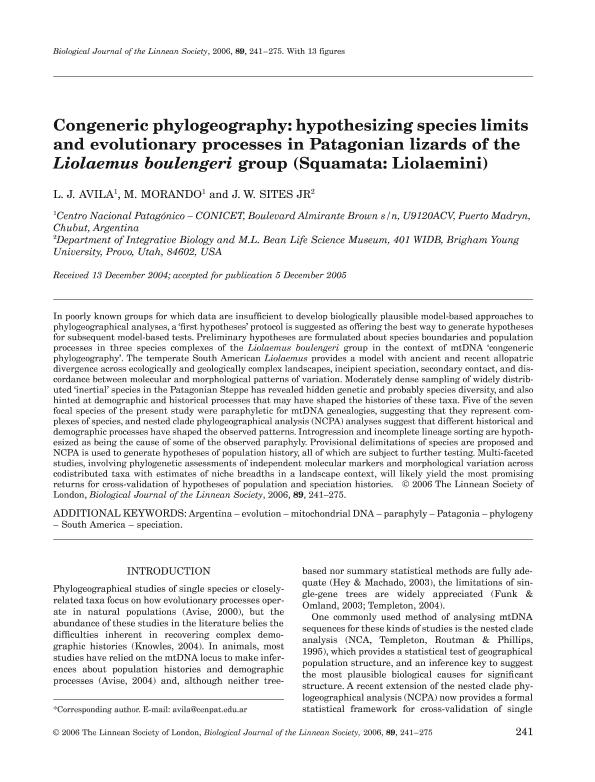Artículo
Congeneric phylogeography: hypothesizing species limits and evolutionary processes in Patagonian lizards of the Liolaemus boulengeri group (Squamata:Liolaemini)
Fecha de publicación:
10/2006
Editorial:
Oxford University Press
Revista:
Biological Journal of The Linnean Society
ISSN:
0024-4066
e-ISSN:
1095-8312
Idioma:
Inglés
Tipo de recurso:
Artículo publicado
Clasificación temática:
Resumen
In poorly known groups for which data are insufficient to develop biologically plausible model-based approaches to phylogeographical analyses, a ‘first hypotheses’ protocol is suggested as offering the best way to generate hypotheses for subsequent model-based tests. Preliminary hypotheses are formulated about species boundaries and population processes in three species complexes of the Liolaemus boulengeri group in the context of mtDNA ‘congeneric phylogeography’. The temperate South American Liolaemus provides a model with ancient and recent allopatric divergence across ecologically and geologically complex landscapes, incipient speciation, secondary contact, and discordance between molecular and morphological patterns of variation. Moderately dense sampling of widely distributed ‘inertial’ species in the Patagonian Steppe has revealed hidden genetic and probably species diversity, and also hinted at demographic and historical processes that may have shaped the histories of these taxa. Five of the seven focal species of the present study were paraphyletic for mtDNA genealogies, suggesting that they represent complexes of species, and nested clade phylogeographical analysis (NCPA) analyses suggest that different historical and demographic processes have shaped the observed patterns. Introgression and incomplete lineage sorting are hypothesized as being the cause of some of the observed paraphyly. Provisional delimitations of species are proposed and NCPA is used to generate hypotheses of population history, all of which are subject to further testing. Multi-faceted studies, involving phylogenetic assessments of independent molecular markers and morphological variation across codistributed taxa with estimates of niche breadths in a landscape context, will likely yield the most promising returns for cross-validation of hypotheses of population and speciation histories.Liolaemus boulengeri group in the context of mtDNA ‘congeneric phylogeography’. The temperate South American Liolaemus provides a model with ancient and recent allopatric divergence across ecologically and geologically complex landscapes, incipient speciation, secondary contact, and discordance between molecular and morphological patterns of variation. Moderately dense sampling of widely distributed ‘inertial’ species in the Patagonian Steppe has revealed hidden genetic and probably species diversity, and also hinted at demographic and historical processes that may have shaped the histories of these taxa. Five of the seven focal species of the present study were paraphyletic for mtDNA genealogies, suggesting that they represent complexes of species, and nested clade phylogeographical analysis (NCPA) analyses suggest that different historical and demographic processes have shaped the observed patterns. Introgression and incomplete lineage sorting are hypothesized as being the cause of some of the observed paraphyly. Provisional delimitations of species are proposed and NCPA is used to generate hypotheses of population history, all of which are subject to further testing. Multi-faceted studies, involving phylogenetic assessments of independent molecular markers and morphological variation across codistributed taxa with estimates of niche breadths in a landscape context, will likely yield the most promising returns for cross-validation of hypotheses of population and speciation histories.
Palabras clave:
ARGENTINA
,
EVOLUTION
,
MTDNA
,
PARAPHYLY
,
PATAGONIA
,
PHYLOGENY
,
SOUTH AMERICA
,
SPECIATION
Archivos asociados
Licencia
Identificadores
Colecciones
Articulos(CCT-CENPAT)
Articulos de CTRO.CIENTIFICO TECNOL.CONICET - CENPAT
Articulos de CTRO.CIENTIFICO TECNOL.CONICET - CENPAT
Citación
Avila, Luciano Javier; Morando, Mariana; Sites, J. W.; Congeneric phylogeography: hypothesizing species limits and evolutionary processes in Patagonian lizards of the Liolaemus boulengeri group (Squamata:Liolaemini); Oxford University Press; Biological Journal of The Linnean Society; 89; 2; 10-2006; 241-275
Compartir
Altmétricas




